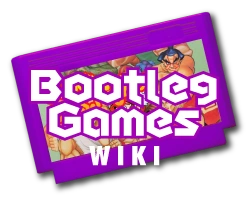(Adding categories) |
(Undo revision 39976 by TwilightSparkleLover11 (talk)) |
||
| Line 92: | Line 92: | ||
[[Category:Crossover Games]] |
[[Category:Crossover Games]] |
||
[[Category:Hacks]] |
[[Category:Hacks]] |
||
| − | [[Category:Bootlegged fanmade hacks]] |
||
Revision as of 21:27, 14 November 2019
Sonic the Hedgehog 4 is a pirate game for the SNES by Peruvian scene organization Twin Eagles Group. In actuality, it is a hack of Speedy Gonzales: Los Gatos Bandidos. Notable features include Sonic's new ability to kick, and missions to free Marios from cages (upon which the latter exclaims his own name). On some emulators, the game freezes completely after four levels.
Overview
Sonic the Hedgehog's gameplay. Note the imprisoned Mario and the glitched background.
A hack by Peruvian sceners Twin Eagles Group, released in cartridge form with their permission[1]; later pirate cartridges were released under the name "Sonic the Hedgehog 4" and "Sonic & Knuckles".
The hack itself replaces Speedy Gonzales with Sonic and the imprisoned mice with Mario. There is some voice acting in this hack, recorded by the hackers themselves to replace the voices in the original game, with Mario yelling "Mario!", when he's rescued and Sonic yelling "Sonic, Sonic!" when he picks up speed shoes. Mario works as a checkpoint, just like the mice in the original game. The cheese pieces have been replaced with rings, although Sonic has a health meter as indicated by the hearts at the bottom left of the screen. Sonic's sprites are from Sonic The Hedgehog 2 on the Sega Mega Drive, except for his handling sprites, which are from Sonic The Hedgehog 3.
The backgrounds are glitched, being rendered in a red gradient which makes them look disjointed. However, they're normal during boss fights. The level order has been altered too, as the forest (the second stage in the original game) is now the first stage, followed by a castle and what appears to be a futuristic spaceship. The game can crash on the third level after hitting a switch (a glitch which is also present in the original Speedy Gonzales ROM if played on some emulators) although it can be bypassed. After a level is completed, a running Sonic with a glitchy palette (probably Speedy's) appears on the screen and the score is calculated. Unlike the original game, this screen doesn't show how much cheese (rings) has been collected, how much time was left or how many mice (Marios) were rescued.
Mario checkpoints are very common in the game, which is quite strange. However, the reason for all these oddly placed "checkpoints" is because Speedy Gonzales: Los Gatos Bandidos has a strong emphasis on rescuing trapped mice, more so than actually getting to the end of the screen (so it's more of a collecting game than a standard left-to-right platformer). However, the first level of Sonic The Hedgheog 4 is the "Surely Woods" level in Los Gatos Bandidos, picked presumably because unlike the others, it's a very linear "fast" level and the Marios aren't hidden too well.
Music
The songs can be found in Options as a Sound Test. Plus, some of the tracks were removed and replacing the same tracks.
| Name | No. |
|---|---|
| El Gato Battle #2 | 00, 02, 04, 05, 07, 08, 11, 13 |
| Ancient Keep | 01 |
| Galactical Galaxies | 03, 12 |
| El Gato Battle #1 | 06 |
| Continue? | 09, 16, 17 |
| Introduction | 10 |
| Staff Roll | 14 |
| The Mice Have Been Rescued | 15 |
Credits
- Coding: Alex
- Animations: Mr.Byte/TEG
- "Sonic!" voice: Mongrut (?)
Video
Gallery
- Main article: Sonic the Hedgehog (SNES)/gallery
Trivia
- Much of the music and some of the levels were removed from the original game, with the missing levels only accessible through save state hacking.
- This hack is similar to Sonic 6 for the Game Boy, because both are Speedy Gonzales games hacked to include Sonic in them, released for Nintendo platforms and the first level is a forest.
- Twin Eagles Group also made Sonic the Hedgehog 2 for the SNES, which is a hack of Sparkster, an not-LT related game.
- The ending screen features the line "Sonic loves Nintendo, Mario loves Sega". This became true when Sega stopped making its own consoles and started releasing official Sega games (with Sega exclusive characters) on Nintendo consoles.
Reference
- ↑ Twin Eagles Group rom hacks (PGC Forums)
| List of games by Twin Eagles Group |
|---|
|

